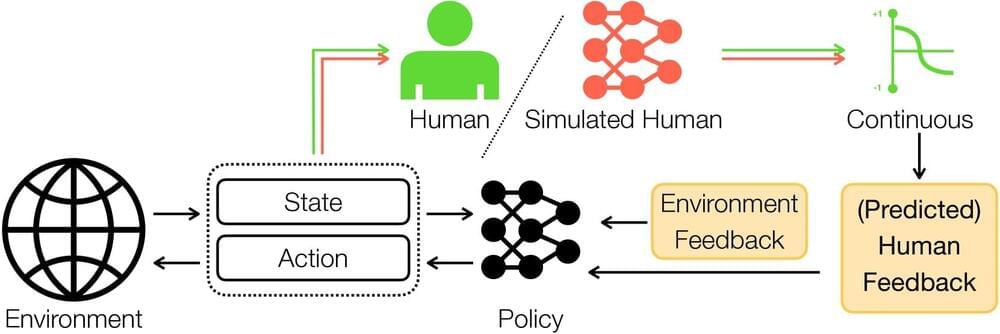Dec 3, 2024
Jensen Huang Wants to Make AI the New World Infrastructure
Posted by Shubham Ghosh Roy in category: robotics/AI
Nvidia CEO Jensen Huang has a plan to bring AI infrastructure to countries around the world, and he’s pitching it in person.
Nvidia CEO Jensen Huang has a plan to bring AI infrastructure to countries around the world, and he’s pitching it in person.
Critical CVE-2024–10905 in SailPoint’s IdentityIQ (CVSS 10.0) risks unauthorized file access. Update now.
Large language models such as OpenAI’s o1 have electrified the debate over achieving artificial general intelligence, or AGI. But they are unlikely to reach this milestone on their own.

I had wondered if AI could just learn and advance from it s users.
During your first driving class, the instructor probably sat next to you, offering immediate advice on every turn, stop and minor adjustment. If it was a parent, they might have even grabbed the wheel a few times and shouted “Brake!” Over time, those corrections and insights developed experience and intuition, turning you into an independent, capable driver.
Results from a recent clinical trial led by physicians at Emory University and Grady Health System indicate that a twice-yearly injection of Lenacapavir offers a 96% reduced risk of HIV infection overall, significantly more effective than the daily oral PrEP.
Inside the surprisingly meaningful, unexpectedly heartbreaking, and deeply confusing reality of AI relationships.
“In vivo measurement of basement membrane stiffness showed that ISCs reside in a more rigid microenvironment at the bottom of the crypt,” the article’s authors wrote. “Three-dimensional and two-dimensional organoid systems combined with bioengineered substrates and a stretching device revealed that PIEZO channels sense extracellular mechanical stimuli to modulate ISC function.”
The paper’s first author is Meryem Baghdadi, PhD, a former researcher at SickKids, and the paper’s senior authors are Tae-Hee Kim, PhD, a senior scientist at SickKids, and Danijela Vignjevic, PhD, a research director at Institut Curie. The study they led expanded on the work of one of the paper’s co-authors, Xi Huang, PhD, a senior scientist at SickKids.
In 2018, Huang found that PIEZO ion channels influence tumor stiffening in brain cancer. Inspired by this research, the collaborators in the current study set out to explore how stem cells in the intestines use PIEZO channels to stay healthy and function properly.
“Kepler-51e has an orbit slightly larger than Venus and is just inside the star’s habitable zone, so a lot more could be going on beyond that distance if we take the time to look,” said Dr. Jessica Libby-Roberts.
How many exoplanets are in the cosmos and what can they tell us about planetary formation and evolution? This is what a recent study published in The Astronomical Journal hopes to address as an international team of more than 50 researchers announced the discovery of Kepler-51e, which is the fourth planet residing in the Kepler-51 system. This discovery holds the potential to expand our knowledge of exoplanets, specifically regarding their formation and evolution, as Kepler-51e challenges previous notions about low-density exoplanets, also called “puff planets” or “Super-Puffs”
“Super puff planets are very unusual in that they have very low mass and low density,” said Dr. Jessica Libby-Roberts, who is a Postdoctoral Scholar in the Department of Astronomy and Astrophysics at Penn State University and second author of the study. “The three previously known planets that orbit the star, Kepler-51, are about the size of Saturn but only a few times the mass of Earth, resulting in a density like cotton candy.”
“These sites act like Velcro with different colors – designed so that only strands with matching ‘colors’ (in fact, complementary DNA sequences) can connect,” said Dr. Luu.
This method allows researchers to construct customizable, highly specific architectures that can perform intricate tasks at the molecular level.
One of the most promising applications of this technology is its ability to create nanorobots capable of delivering drugs directly to targeted areas within the body.
“Discovering liquid water oceans inside the moons of Uranus would transform our thinking about the range of possibilities for where life could exist,” said Dr. Douglas Hemingway.
Do the moons of Uranus have interior liquid oceans like the moons of Jupiter and Saturn? This is what a recent study published in Geophysical Research Letters hopes to address as a pair of researchers investigated the likelihood of five Uranus moons, Miranda, Ariel, Umbriel, Titania, and Oberon possessing interior oceans. This study holds the potential to not only help researchers better understand the compositions of these moons, but also establish a framework for sending a spacecraft to Uranus for the first time since NASA’s Voyager 2 in 1986.
For the study, the researchers used computer models to simulate changes in each moon’s wobble with the goal of estimating the potential amount of liquid water that each moon could be harboring. This technique could be used to detect liquid oceans within these moons, thus increasing the feasibility of a future spacecraft mission to Uranus.
Continue reading “NASA’s Next Mission to Uranus: Searching for Liquid Water Oceans on Icy Moons” »